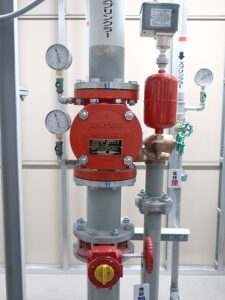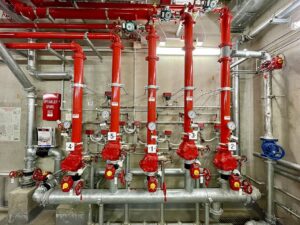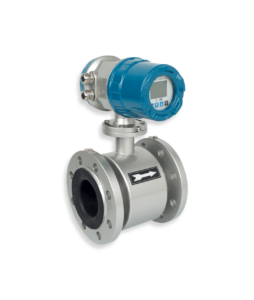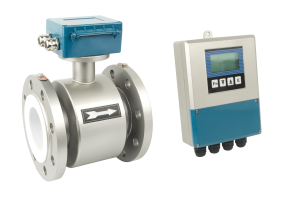INTRODUCTION
But before we talk about the electromagnetic flowmeter’s application in a fire system, we need to grasp what a fire system or using the proper lingua “fire suppression system” is all about.
FIRE SUPPRESSION SYSTEM A system of flame or fire suppressants is placed to extinguish, control, or, in some extremely specialized instances, completely prevent flames from spreading or even occurring. It is a necessary component of any fire-fighting system. Any engineering collection of elements meant to extinguish the fire is referred to as “fire suppression.” This can be accomplished by using extinguishing substances such as water, foam, or chemical compounds to put out the fire.
The fire suppression systems have an amazingly great variety of usage, bringing forth many different types of suppression systems for different applications and industries.

HOW DOES THE FIRE SUPPRESSION SYSTEM WORK?
The majority of fire suppression systems have early detection systems that identify fire at an infant stage, these components identify the presence of flames or smoke which is the first stage of a fire outbreak. The suppression system will now sound the alarm, so the blaze can be subdued before it has the opportunity to spread hence becoming out of control. Fire suppression systems can be considered to be “active” fire protection methods because the system is initiated in immediate response to the presence of fire.
TYPES OF FIRE SUPPRESSION SYSTEMS
Here is a list of the fire suppression systems currently available in the world today.
- Gaseous Agents
- Chemical Agent Systems
- Wet Chemical
- Dry Chemical
- Fully Automatic Suppression Systems
- Fire Sprinkler Systems
- Deluge
- Electronic
- Foam Water Sprinkler
- Water Spray
- Water Mist
- Wet Pipe
- Wet Pipe Antifreeze
- Dry Pipe
- Pre-action
- Fully Automatic Vehicle Fire Suppression Systems
- Manual Vehicle Fire Suppression Systems
- External Water Spray System.
FIRE SPRINKLER SYSTEMS
We’ll be focusing on fire sprinkler systems for the sake of this article, which begs the question, what exactly is a FIRE SPRINKLER SYSTEM?
The sprinkler system is a fire suppression system that includes a water supply system that provides suitable pressure and flow rate to the water distribution piping system that houses the fire sprinklers. Despite their widespread use in industries and large commercial buildings, modern technology has enabled the creation of systems that are affordable for homes and small structures.
Fire sprinkler systems are widely utilized throughout the world, with more than 40 million sprinkler heads installed each year. The fire sprinkler system has a high success record, with over 96 percent of fires being extinguished in buildings that were totally equipped with the system.
FLOWMETER IN A FIRE SPRINKLER SYSTEM
So what is the application of a flowmeter in a fire sprinkler system? Firstly, there are various adaptations to the electromagnetic flowmeter and in this case, the adaptation is called a water fire line flow meter, which is a device that is designed for sending an alarm to a fire panel and also to the fire department when there is a constant flow of water through the piping of the fire sprinkler from a triggered sprinkler head or a leak in the system.
The electromagnetic flowmeter is also known as a water flow meter when it involves fire suppression systems are installed with a plastic vane or paddle which is fixed through an opening in sizes two-inch through eight-inch schedule 40 or schedule 10 fire sprinkler pipe, either flat or straight up. In the event where their movement of water is greater than 10 gallons per minute the vane or paddle immediately activates a switch that sends a signal to an alarm bell and an electronic panel.
FEATURES OF AN ELECTROMAGNETIC FLOWMETER
Electromagnetic flowmeters, also known as magnetic flowmeters or mag meters, are in high demand because they have fewer obstructions in the pipe, are cost-effective for particularly aggressive chemicals and slurries, and provide highly accurate volumetric flow measurements. Electromagnetic flowmeters come in a variety of liner materials, electrode configurations, and line diameters to suit a variety of applications. They can also measure fluids in both directions and are quite successful at monitoring volumetric flows at both low and high flow rates.
The sensors within the inline electromagnetic flowmeters measure an induced voltage generated by the flow of fluids through the pipe. It also has a transmitter that works in combination with the sensor, taking the voltage generated in the sensor, converting the voltage into flow measurements, and then transmits the flow measurements to a control system.
CONCLUSION
Fire is one of the first and most important discoveries of man, if not the greatest, harnessing fire and bending the will of the flames into constructive uses help man move from dealing in caves to conquering the planet. But, the flames have a will of their own, and as it is said “fire is a good servant and a terrible master”, therefore controlling the flames from doing great damage and becoming an inferno has been a keen interest of man. To this end, humanity has invented and will continue to invent and find new ways of taming the flames.
But as is common knowledge “prevention is better than cure”, therefore the best way to protect lives and properties, to the greater extent the planet is to make sure the flames are starved of substances that nourish their growth, and if this is not possible, adequate fire suppression systems are to be installed for safety with an electromagnetic flowmeter installed as help in alerting the situation to those who can fight and are trained to fight the flames.



